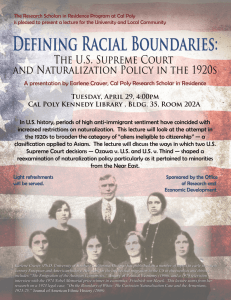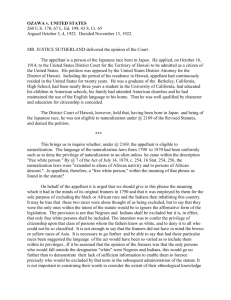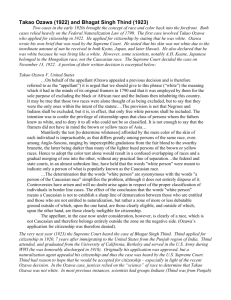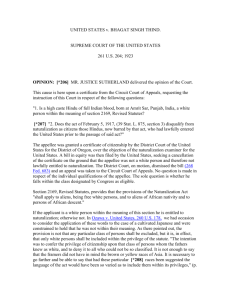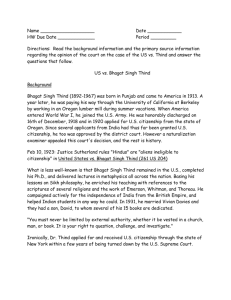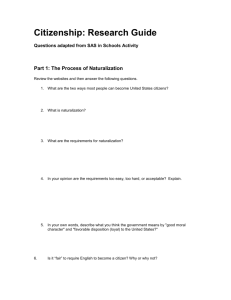The Importance of “Whiteness” in American Legal History
advertisement
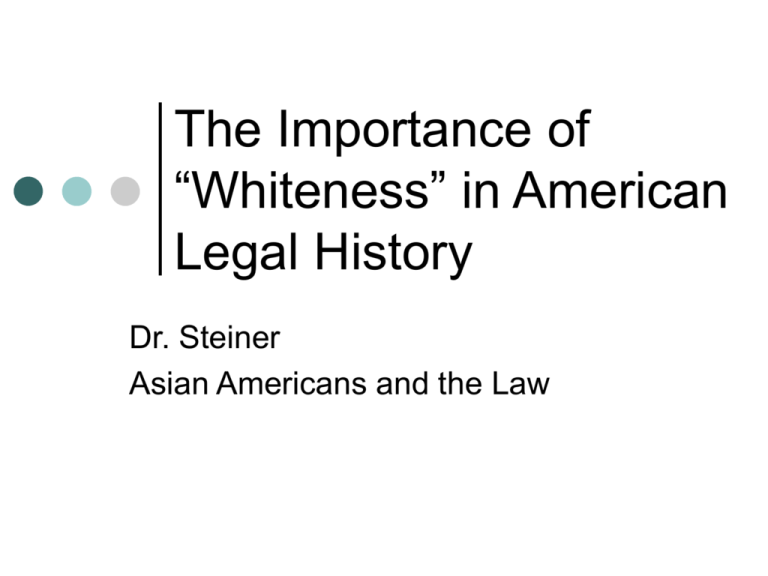
The Importance of “Whiteness” in American Legal History Dr. Steiner Asian Americans and the Law What is “race”? U.S. Map First Federal Congress Naturalization Act of 1790 That any alien, being a free white person, who shall have resided within the limits and under the jurisdiction of the United States for the term of two years, may be admitted to become a citizen thereof . . . . Why “free white person”? Why “free white person”? Why “free white person”? Scientific Theories about Race: Carolus Linnaeus (1707-1778) Linnaeus proposed four races: Americanus, Asiaticus, Africanus, and Europeanus Each race had particular traits: Europeanus: white, gentle, inventive Asiatic: yellow, melancholy, greedy Americanus: red, ill-tempered, subjugated Africanus: black, impassive, lazy Scientific Theories about Race: J.F. Blumenbach (1752-1840) Blumenbach used the word “race” in 1775 to classify humans into five divisions: Caucasian, Mongolian, Ethiopian, American, and Malay. Scientific Theories about Race: J.F. Blumenbach Blumenbach coined the term “Caucasian” because he believed that the Caucasus region of Asia Minor produced “the most beautiful race of men.” “White . . . we may fairly assume to be the primitive color of mankind, since it is very easy to degenerate into brown, but very much more difficult for dark to become white.” Scientific Theories about Race: Georges Cuvier (1769-1832) Cuvier proposed three races: Caucasian, Mongol, and Negro “The white race, with oval face, straight hair and nose, to which the civilized peoples of Europe belong and which appear to us the most beautiful of all, is also superior to others by its genius, courage and activity.” Huxley, On the Methods and Results of Ethnology (1865) Five races Xanthochroic (fair whites) Melanochroic (dark whites) Australioid (chocolate brown) Negroid (brown black) Mongoloid (yellow) Huxley, On the Methods and Results of Ethnology (1865) It is needless to remark upon the civilization of these two great stocks (Xanthochroic and Melanochroic). With them has originated everything that is highest in science, in art, in law in politics, and in mechanical inventions. In their hands, at the present moment, lies the order of the social world, and to them its progress is committed. Thomas Jefferson, Notes on the State of Virginia (1781) The first difference which strikes us is that of colour. . . . [T]he difference is fixed in nature . . . . And is this difference of no importance? Is it not the foundation of a greater or less share of beauty in the two races? Are not the fine mixtures of red and white, the expressions of every passion by greater or less suffusions of colour in the one, preferable to that eternal monotony, which reigns in the countenances, that immoveable veil of black which covers all the emotions of the other race? Thomas Jefferson, Notes on the State of Virginia (1781) Add to these, flowing hair, a more elegant symmetry of form, their own judgment in favour of the whites, declared by their preference of them, as uniformly as is the preference of the Oranootan for the black women over those of his own species. The circumstance of superior beauty, is thought worthy attention in the propagation of our horses, dogs, and other domestic animals; why not in that of man? Thomas Jefferson, Notes on the State of Virginia (1781) Comparing them by their faculties of memory, reason, and imagination, it appears to me, that in memory they are equal to the whites; in reason much inferior, as think one could scarcely be found capable of tracing and comprehending the investigations of Euclid; and that in imagination they are dull, tasteless, and anomalous. . . . Thomas Jefferson, Notes on the State of Virginia (1781) I advance it therefore as a suspicion only, that the blacks, whether originally a distinct race, or made distinct by time and circumstances, are inferior to the whites in the endowments both of body and mind. . . . This unfortunate difference of colour, and perhaps of faculty, is a powerful obstacle to the emancipation of these people. Who’s “white” in NineteenthCentury America? Irish, Jews, Italians, Eastern Europeans “become white” Skin Color and Notions of Beauty Skin Color and Notions of Beauty Ex parte Ah Yup (1878) Framing the Issue: “The only question is, whether the statute authorizes the naturalization of a native of China of the Mongolian race.” “The questions are: 1. Is a person of the Mongolian race a ‘white person within the meaning of the statute? 2. Do these provisions exclude all but white persons and persons of African nativity or African descent?” Ex parte Ah Yup A Commonly Accepted Meaning of “White”? Words in a statute, other than technical terms, should be taken in their ordinary sense. But these words in this country, at least, have undoubtedly acquired a well settled meaning in common popular speech, and they are constantly used in the sense so acquired in the literature of the country, as well as in common parlance. As ordinarily used everywhere in the United States, one would scarcely fail to understand that the party employing the words “white person” would intend a person of the Caucasian race. Ex parte Ah Yup 1870 Congressional Debates At the time of the amendment, in 1870, extending the naturalization laws to the African race, Mr. Summer made repeated and strenuous efforts to strike the word “white” from the naturalization laws, or to accomplish the same object by other language. It was opposed on the sole ground that the effect would be to authorize the admission of Chinese to citizenship. Every senator, who spoke upon the subject, assumed that they were then excluded by the term “white person,” and that the amendment would admit them . . . . Ex parte Ah Yup 1870 Congressional Debates Senator Morton, in the course of the discussion said: “This amendment involves the whole Chinese problem. . . . The country has just awakened to the question and to the enormous magnitude of the question, involving a possible immigration of many millions, involving another civilization; involving labor problems that no intellect can solve without study and time. Are you now prepared to settle the Chinese problem, thus in advance inviting that immigration?” Ex parte Ah Yup 1870 Congressional Debates Senator Sumner replied: “Senators undertake to disturb us in our judgment by reminding us of the possibility of large numbers swarming from China; but the answer to all this is very obvious and very simple. If the Chinese come here they will come for citizenship, or merely for labor. If they come for citizenship then in this desire to they give a pledge of loyalty to our institutions, and where is the peril in such vows? They are peaceful and industrious; how can their citizenship be the occasion of solicitude?” In Re Saito (1894) Are Japanese “white”? “The Japanese, like the Chinese, belong to the Mongolian race, and the question presented is whether they are included within the term ‘white persons.’” Sumner’s unsuccessful attempt to amend naturalization law In Re Saito (1894) The words of a statute are to be taken in their ordinary sense, unless it can be shown that they are used in a technical sense. From a common, popular standpoint, both in ancient and modern times, the races of mankind have been distinguished by difference in color, and they have been classified as the white, black, yellow, and brown races. In Re Saito (1894) And this is true from a scientific point of view. Writers on ethnology and anthropology base their division of mankind upon differences in physical rather than in intellectual or moral character, so that difference in color, conformation of skull, structure and arrangement of hair, and the general contour of the face are the marks which distinguish the various types. In Re Saito (1894) But, of all these marks, the color of the skin is considered the most important criterion for the distinction of race, and it lies at the foundation of the classification which scientists have adopted. Blumenbach, in 1781, divided mankind into five principal types,-- the Caucasian or white, Mongolian or yellow, Ethiopian or black, American or red, and Malay or brown. Cuvier simplified this classification into Caucasian, Mongol, and Negro, or white, yellow, and black races. In Re Saito (1894) Other writers make a still larger number of distinct races. It is said that Prof. Huxley's division of mankind is the most satisfactory. He distinguishes four principal types, and he points out the marked physical characteristics of each. These types are the Australioid (chocolate brown), Negroid (brown black), Mongoloid (yellow), and Xanthochroic (fair whites). To these he adds a fifth variety, the Melanochroic (dark whites). Japanese Immigrants and Citizenship Despite cases such as Saito, there were over 400 naturalized Japanese in 1910 Supreme Court definitively decided in 1922 whether Japanese could be “white” in Ozawa. Filipinos and Exclusion As residents of an American territory, Filipinos were neither aliens nor American citizens, but “nationals” The exclusionist policy toward Asians didn’t apply to Filipinos Tydings-McDuffie Act (1934) established Philippines as a commonwealth and provided for independence within ten years • As residents of an independent country, Filipinos then could be excluded • An annual quota of 50 was established Act of July 26, 1894 Any alien of the age of twenty-one years and upwards who has enlisted or may enlist in the United States navy or marine corps, and has served or may hereafter serve five consecutive years in the United States navy or one enlistment in the United States marine corps, and has been or may hereafter be honorably discharged, shall be admitted to become a citizen of the United States upon his petition, without any previous declaration of his intention to become such; and the court admitting such alien shall, in addition to proof of good moral character, be satisfied by competent proof of such person's service in and honorable discharge from the United States navy, or marine corps. In re Alverto (1922) Alverto served in U.S. Navy for seven years and was honorably discharged. Can he become a citizen under the 1894 Act? No, because the Navy didn’t make him white. Naturalization is still limited to “aliens being free white persons, and to aliens of African nativity and to persons of African descent.” In re Alverto (1922) Section 2169 was intended to limit the application of the whole body of the naturalization laws to aliens being free white persons or of the African race. ‘Free white persons’ includes members of the white, or Caucasian race, as distinct from the black, red, yellow, and brown races. The use of the words ‘white persons’ clearly indicates the intention of Congress to maintain a line of demarcation between races and to extend the privilege of naturalization only to those of the races named. The petitioner is, ethnologically speaking, onefourth of the white or Caucasian race and threefourths of the brown or Malay race. In re Alverto (1922) The applicant's service in the navy does not affect his status under section 2169 (“free white person”). It has been repeatedly held that service in and an honorable discharge from the military service of the United States does not extend the right of naturalization to those persons who are beyond its provision under section 2169. It is apparent, therefore, that, however commendable the service of the applicant in the navy, the provisions of law in relation to naturalization of persons in the army and navy were intended by Congress to grant to those serving in the army and navy, who were of the white or African races, exemption from the necessity of a previous declaration of intention and from the necessity of proving residence for five years within the United States, but were not intended to extend the benefit of the naturalization laws to those not coming within the racial qualifications. In re Alverto (1922): Filipinos and Naturalization Citizens of the Philippine Islands or of Porto Rico, while not citizens of the United States, are not aliens, and, prior to the passage of the Act of 1906, were not capable of becoming naturalized for two reasons: First, the naturalization laws of the United States applied only to aliens; and, second, they required a renunciation of former allegiance. . . . The effect of section 30 was to make applicable to citizens of the Philippine Islands and Porto Rico those provisions which had theretofore applied only to aliens. If the limitations of section 2169 apply to one provision of the naturalization laws, they must apply to all and consequently to section 30 of the Act of 1906. Section 2169 was intended to limit the application of the whole body of the naturalization laws to aliens being free white persons or of the African race. 'Free white persons' includes members of the white, or Caucasian race, as distinct from the black, red, yellow, and brown races. In re Alverto (1922): Filipinos and Naturalization Congress did not intend to extend the privilege of citizenship to those who had become citizens of the Philippine Islands under the Act of 1902, unless they were free white persons or of African nativity or descent. Ozawa v. United States, 260 U.S. 178 (1922) Ozawa was of “the Japanese race born in Japan.” He applied for citizenship, which was opposed by the government. “Including the period of his residence in Hawaii appellant had continuously resided in the United States for 20 years. He was a graduate of the Berkeley, Cal., high school, had been nearly three years a student in the University of California, had educated his children in American schools, his family had attended American churches and he had maintained the use of the English language in his home. That he was well qualified by character and education for citizenship is conceded.” Ozawa v. United States, 260 U.S. 178 (1922) Ozawa’s brief argued: The Japanese are “free.” They are, at least the dominant strains, are “white persons,” speaking an Aryan tongue and having Caucasian root stocks; a superior class fit for citizenship. . . . The Japanese are commonly called “The Yankees of the Orient.” Ozawa v. United States, 260 U.S. 178 (1922) Attorney General of California’s amicus brief argued: The American family reared along the lines of American traditions with the father managing the farm, the mother presiding in the home, and the children during their younger years attending school, cannot compete with the Oriental farm life wherein children and mother join with the father in the actual farm labor, and in addition do not enjoy conditions of life which are demanded by the American standard of living. Ozawa v. United States, 260 U.S. 178 (1922) Ozawa also argued that the original Naturalization Act was meant to exclude only Indians and those of African descent. The court responded: “It may be true that those two races were alone thought of as being excluded, but to say that they were the only ones within the intent of the statute would be to ignore the affirmative form of the legislation. The provision is not that Negroes and Indians shall be excluded, but it is, in effect, that only free white persons shall be included. The intention was to confer the privilege of citizenship upon that class of persons whom the fathers knew as white, and to deny it to all who could not be so classified. It is not enough to say that the framers did not have in mind the brown or yellow races of Asia.” Ozawa v. United States, 260 U.S. 178 (1922) We have been furnished with elaborate briefs in which the meaning of the words 'white person' is discussed with ability and at length, both from the standpoint of judicial decision and from that of the science of ethnology. It does not seem to us necessary, however, to follow counsel in their extensive researches in these fields. It is sufficient to note the fact that these decisions are, in substance, to the effect that the words import a racial and not an individual test, and with this conclusion, fortified as it is by reason and authority, we entirely agree. Ozawa v. United States, 260 U.S. 178 (1922) Manifestly the test afforded by the mere color of the skin of each individual is impracticable, as that differs greatly among persons of the same race, even among Anglo-Saxons, ranging by imperceptible gradations from the fair blond to the swarthy brunette, the latter being darker than many of the lighter hued persons of the brown or yellow races. Hence to adopt the color test alone would result in a confused overlapping of races and a gradual merging of one into the other, without any practical line of separation. Ozawa v. United States, 260 U.S. 178 (1922) Beginning with [In re Ah Yup], the federal and state courts, in an almost unbroken line, have held that the words ‘white person’ were meant to indicate only a person of what is popularly known as the Caucasian race. . . . With the conclusion reached in these several decisions we see no reason to differ. . . . The determination that the words ‘white person’ are synonymous with the words ‘a person of the Caucasian race’ simplifies the problem, although it does not entirely dispose of it. Controversies have arisen and will no doubt arise again in respect of the proper classification of individuals in border line cases. The appellant, in the case now under consideration, however, is clearly of a race which is not Caucasian. . . Racial Pre-requisite Cases United States v. Thind (1922) Is Thind “White”? Asian Indians are Caucasians Caucasians are White Thind is from India Therefore, . . . Racial Pre-requisite Cases Thind isn’t White because “free white person” are “words of common speech” Finding Thind is White would be a shocking result to Whites What happened to science? United States v. Thind (1923) “Is a high-caste Hindu, of full Indian blood, born at Amritsar, Punjab, India, a white person within the meaning of section 2169 ?” Thind argues he’s Caucasian, which is synonymous with white United States v. Thind (1923) In Ozawa, the court had “held that the words imported a racial and not an individual test and were meant to indicate only persons of what is popularly known as the Caucasian race.” United States v. Thind (1923) In the endeavor to ascertain the meaning of the statute we must not fail to keep in mind that it does not employ the word ‘Caucasian,’ but the words ‘white persons,’ and these are words of common speech and not of scientific origin. It may be true that the blond Scandinavian and the brown Hindu have a common ancestor in the dim reaches of antiquity, but the average man knows perfectly well that there are unmistakable and profound differences between them to-day. United States v. Thind (1923) What we now hold is that the words ‘free white persons’ are words of common speech, to be interpreted in accordance with the understanding of the common man, synonymous with the word ‘Caucasian’ only as that word is popularly understood. As so understood and used, whatever may be the speculations of the ethnologist, it does not include the body of people to whom the appellee belongs. It is a matter of familiar observation and knowledge that the physical group characteristics of the Hindus render them readily distinguishable from the various groups of persons in this country commonly recognized as white. Wu, From Black to White and Back Again What’s the larger meaning of racial pre-requisite cases? Classifying groups as foreign makes it easier to deny individuals who are members of group the equal protection of laws Forms part of a larger pattern of white supremacy What are the lessons that White by Law teaches Asian Americans? Asian Americans helped shape law Law has shaped Asian Americans Asian Americans’ quest for assimilation to “whiteness” has failed The citizen-foreigner paradigm When Asian Americans are White
